Abstract
The effect of amikacin and two new macrolides (roxithromycin and azithromycin) used either alone or in combination with recombinant tumor necrosis factor (TNF) to inhibit or kill Mycobacterium avium complex in human macrophages was examined in vitro. Macrophage monolayers infected with M. avium complex (strain 101, serotype 1) were treated with antibiotics or TNF by using three different protocols: (i) antibiotics or TNF was added to the monolayers immediately after infection and washed out after 24 h, (ii) antibiotics or TNF was replenished daily for 4 dys, or (iii) infected macrophage monolayers were treated with antibiotics plus TNF for 4 consecutive days. The number of viable intracellular bacteria was determined after 2 and 4 days of treatment by lysing cultured macrophages. Treatment for 24 h resulted in an inhibition of growth, as determined by macrophage lysis at day 4, for all three antimicrobial drugs and killing of 22% of intracellular bacteria after treatment with TNF. After treating the monolayers with amikacin, roxithromycin, or azithromycin for 4 consecutive days and replenishing the drug concentration daily, we observed 18 +/- 6, 20 +/- 4, and 22 +/- 1% killing, respectively. TNF (100 U/ml) was added daily to the monolayers, which resulted in 54 +/- 5% killing after 4 days. Combinations of antibiotics with TNF were associated with 62 +/- 3% killing with TNF-azithromycin, 73 +/- 6% killing with TNF-roxithromycin, and 56 +/- 4% killing of intracellular M. avium complex with TNF-amikacin after 4 days. The mycobactericidal effect was enhanced (91 +/- 4% killing by roxithromycinamikacin). Combinations of antimicrobial agents with immunomodulators like TNF may be useful for treatment of M. avium complex infection.
Full text
PDF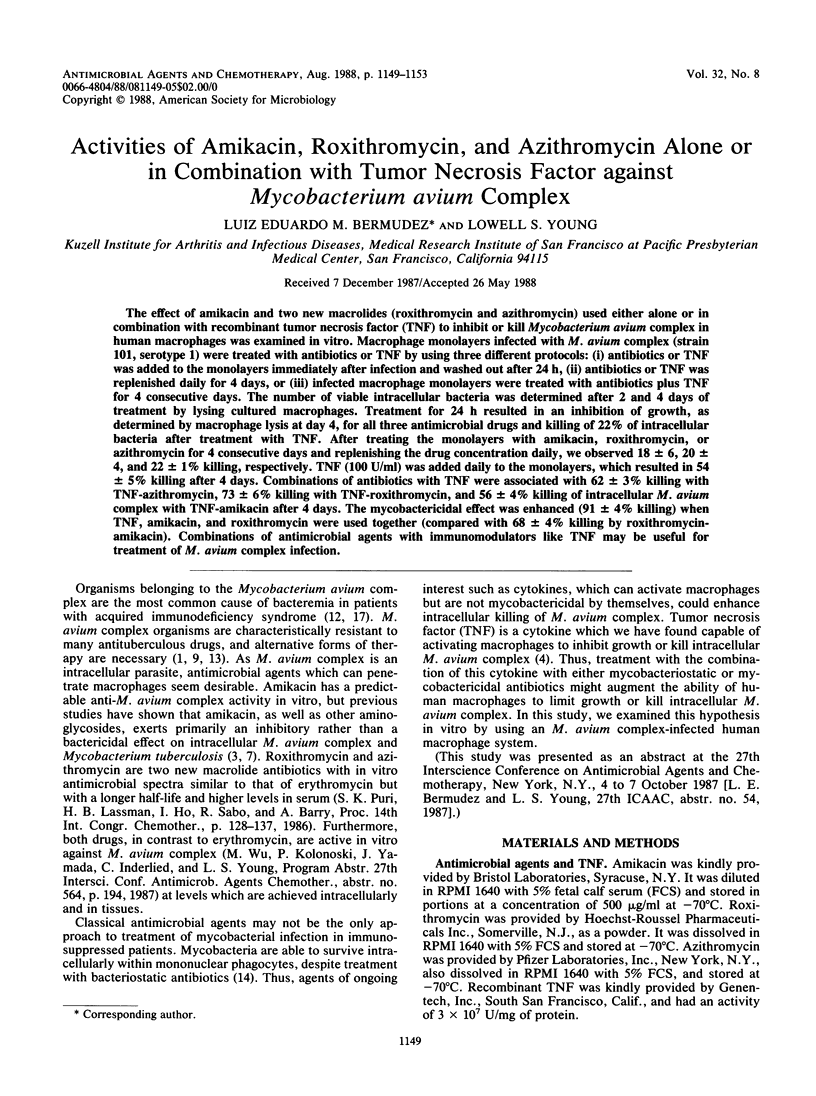
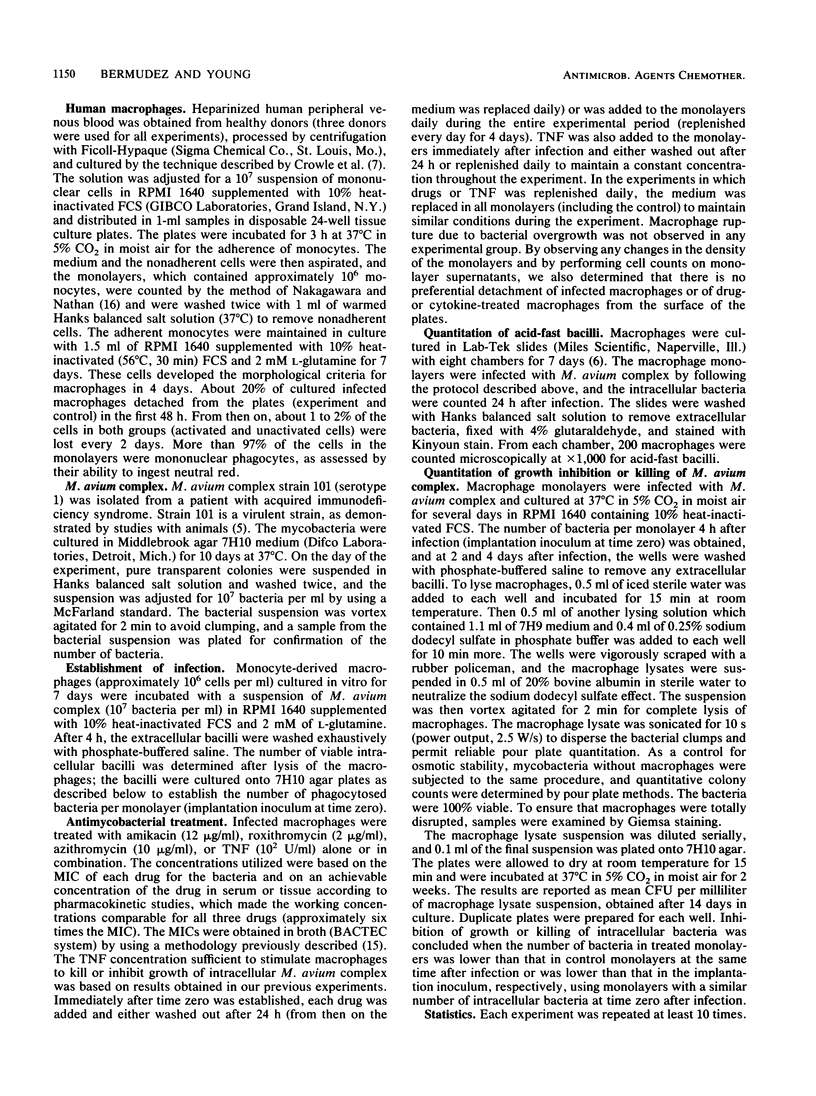
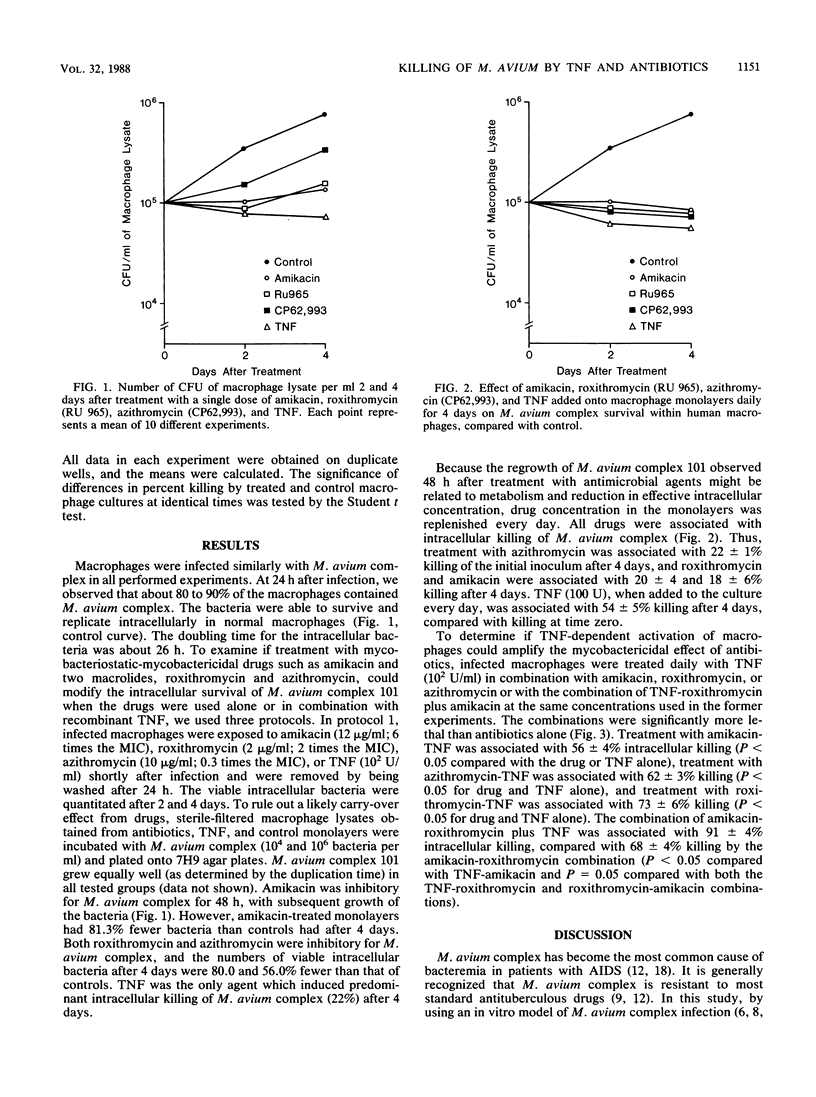
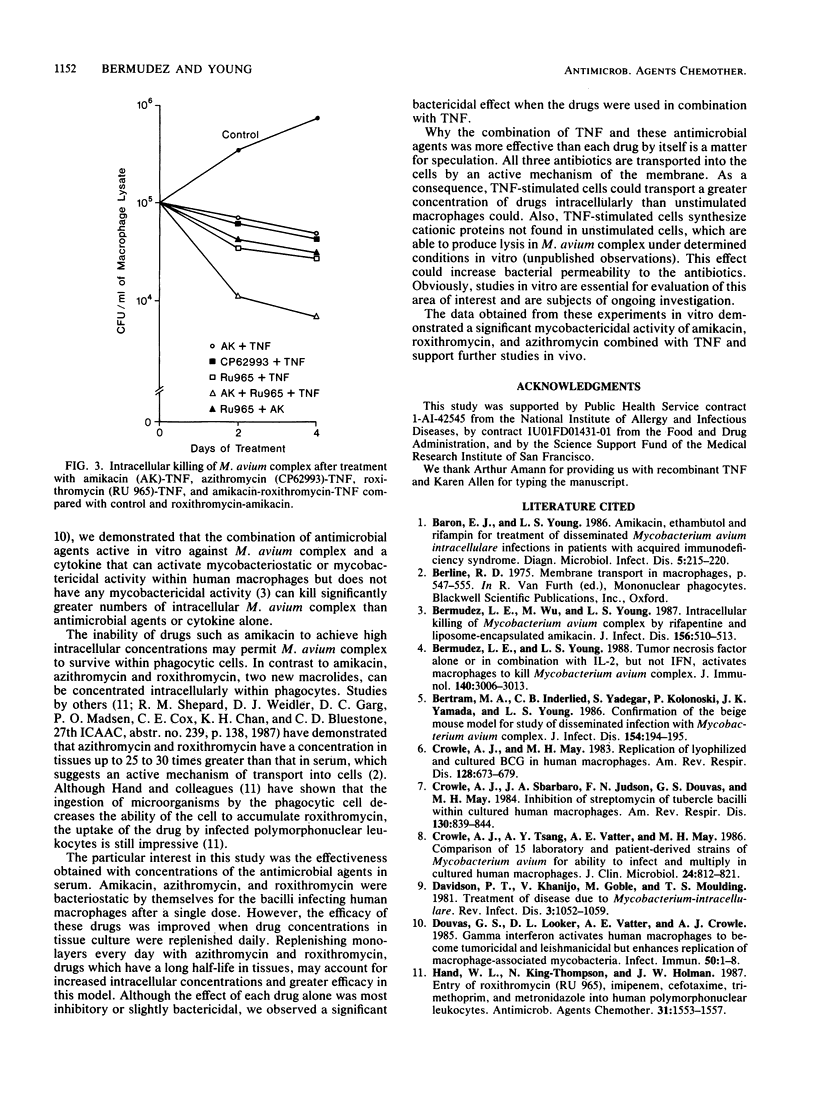
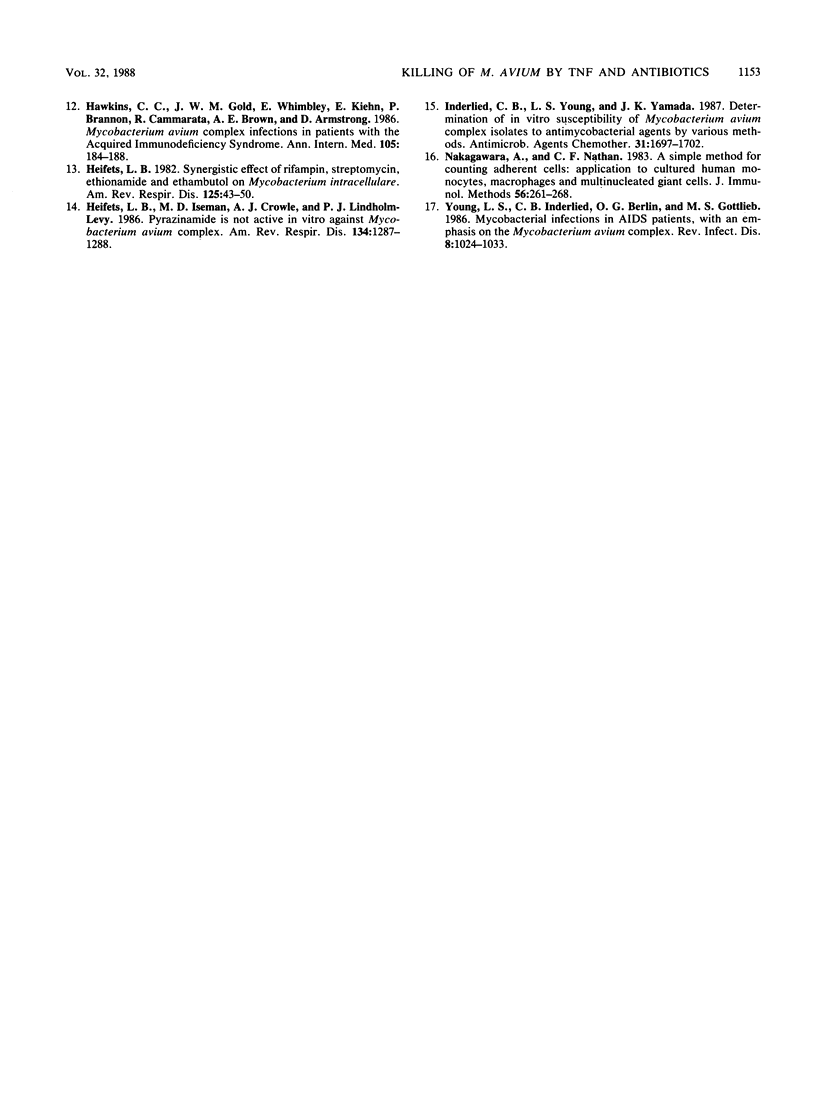
Selected References
These references are in PubMed. This may not be the complete list of references from this article.
- Baron E. J., Young L. S. Amikacin, ethambutol, and rifampin for treatment of disseminated Mycobacterium avium-intracellulare infections in patients with acquired immune deficiency syndrome. Diagn Microbiol Infect Dis. 1986 Sep;5(3):215–220. doi: 10.1016/0732-8893(86)90004-0. [DOI] [PubMed] [Google Scholar]
- Bermudez L. E., Wu M., Young L. S. Intracellular killing of Mycobacterium avium complex by rifapentine and liposome-encapsulated amikacin. J Infect Dis. 1987 Sep;156(3):510–513. doi: 10.1093/infdis/156.3.510. [DOI] [PubMed] [Google Scholar]
- Bermudez L. E., Young L. S. Tumor necrosis factor, alone or in combination with IL-2, but not IFN-gamma, is associated with macrophage killing of Mycobacterium avium complex. J Immunol. 1988 May 1;140(9):3006–3013. [PubMed] [Google Scholar]
- Bertram M. A., Inderlied C. B., Yadegar S., Kolanoski P., Yamada J. K., Young L. S. Confirmation of the beige mouse model for study of disseminated infection with Mycobacterium avium complex. J Infect Dis. 1986 Jul;154(1):194–195. doi: 10.1093/infdis/154.1.194. [DOI] [PubMed] [Google Scholar]
- Crowle A. J., May M. H. Replication of lyophilized and cultured BCG in human macrophages. Am Rev Respir Dis. 1983 Oct;128(4):673–679. doi: 10.1164/arrd.1983.128.4.673. [DOI] [PubMed] [Google Scholar]
- Crowle A. J., Sbarbaro J. A., Judson F. N., Douvas G. S., May M. H. Inhibition by streptomycin of tubercle bacilli within cultured human macrophages. Am Rev Respir Dis. 1984 Nov;130(5):839–844. doi: 10.1164/arrd.1984.130.5.839. [DOI] [PubMed] [Google Scholar]
- Crowle A. J., Tsang A. Y., Vatter A. E., May M. H. Comparison of 15 laboratory and patient-derived strains of Mycobacterium avium for ability to infect and multiply in cultured human macrophages. J Clin Microbiol. 1986 Nov;24(5):812–821. doi: 10.1128/jcm.24.5.812-821.1986. [DOI] [PMC free article] [PubMed] [Google Scholar]
- Davidson P. T., Khanijo V., Goble M., Moulding T. S. Treatment of disease due to Mycobacterium intracellulare. Rev Infect Dis. 1981 Sep-Oct;3(5):1052–1059. doi: 10.1093/clinids/3.5.1052. [DOI] [PubMed] [Google Scholar]
- Douvas G. S., Looker D. L., Vatter A. E., Crowle A. J. Gamma interferon activates human macrophages to become tumoricidal and leishmanicidal but enhances replication of macrophage-associated mycobacteria. Infect Immun. 1985 Oct;50(1):1–8. doi: 10.1128/iai.50.1.1-8.1985. [DOI] [PMC free article] [PubMed] [Google Scholar]
- Hand W. L., King-Thompson N., Holman J. W. Entry of roxithromycin (RU 965), imipenem, cefotaxime, trimethoprim, and metronidazole into human polymorphonuclear leukocytes. Antimicrob Agents Chemother. 1987 Oct;31(10):1553–1557. doi: 10.1128/aac.31.10.1553. [DOI] [PMC free article] [PubMed] [Google Scholar]
- Hawkins C. C., Gold J. W., Whimbey E., Kiehn T. E., Brannon P., Cammarata R., Brown A. E., Armstrong D. Mycobacterium avium complex infections in patients with the acquired immunodeficiency syndrome. Ann Intern Med. 1986 Aug;105(2):184–188. doi: 10.7326/0003-4819-105-2-184. [DOI] [PubMed] [Google Scholar]
- Heifets L. B., Iseman M. D., Crowle A. J., Lindholm-Levy P. J. Pyrazinamide is not active in vitro against Mycobacterium avium complex. Am Rev Respir Dis. 1986 Dec;134(6):1287–1288. doi: 10.1164/arrd.1986.134.6.1287. [DOI] [PubMed] [Google Scholar]
- Heifets L. B. Synergistic effect of rifampin, streptomycin, ethionamide, and ethambutol on Mycobacterium intracellulare. Am Rev Respir Dis. 1982 Jan;125(1):43–48. doi: 10.1164/arrd.1982.125.1.43. [DOI] [PubMed] [Google Scholar]
- Inderlied C. B., Young L. S., Yamada J. K. Determination of in vitro susceptibility of Mycobacterium avium complex isolates to antimycobacterial agents by various methods. Antimicrob Agents Chemother. 1987 Nov;31(11):1697–1702. doi: 10.1128/aac.31.11.1697. [DOI] [PMC free article] [PubMed] [Google Scholar]
- Nakagawara A., Nathan C. F. A simple method for counting adherent cells: application to cultured human monocytes, macrophages and multinucleated giant cells. J Immunol Methods. 1983 Jan 28;56(2):261–268. doi: 10.1016/0022-1759(83)90418-0. [DOI] [PubMed] [Google Scholar]
- Young L. S., Inderlied C. B., Berlin O. G., Gottlieb M. S. Mycobacterial infections in AIDS patients, with an emphasis on the Mycobacterium avium complex. Rev Infect Dis. 1986 Nov-Dec;8(6):1024–1033. doi: 10.1093/clinids/8.6.1024. [DOI] [PubMed] [Google Scholar]


